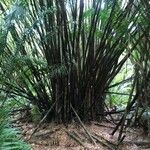Culms 20–30 m, 20–30 cm in diam.; internodes 30–45 cm; wall 1–3 cm thick. Branches several. Culm sheaths deciduous, initially purple, thickly leathery, brown hairy; margins broadly rounded; auricles reflexed, wavy; oral setae absent; ligule 6–12 mm, serrulate; blade reflexed, ovate-lanceolate, 13–38 cm. Leaf sheaths glabrous; ligule 1–3 mm, serrulate; blade usually oblong-lanceolate, to 45 × 10 cm. Inflorescence branches pendulous, long. Pseudospikelets 4–12(–25) cm. Spikelets 10–15 × 3–4 mm; florets 5–8, apical one sterile. Glumes 2, 3–4 mm; lemma broadly ovate, margins ciliate, apex mucronate; palea about as long as lemma, 2-keeled, keels ciliate, 2-veined between and 1-veined on either side of keels. Anthers ca. 6.5 mm, apex apiculate. Pistil ca. 1 cm, shortly hairy. Ovary ovoid; style long; stigma 1, purple. Caryopsis oblong, apex obtuse, plumose.
More
A clump forming bamboo. It can be 25-30-50 m tall. It has rhizomes which spread. The clumps can be 10-15 m wide. The canes can be 35 cm across. They are erect and jointed. The nodes are hairy. The leaf blades are sword shaped and smooth with fine teeth along the edge. The leaves can be 55 cm long. These clasp the canes at their base. The flower is a long panicle which droops.
It is a tropical plant. It often grows in high mountains. It must have temperatures above 5°C. They are frost tender. It cannot tolerate drought. It prefers rich moist soil. In Nepal it grows between 200-1300 m altitude. In Yunnan it grows between 380-1,900 m above sea level. In Cairns Botanical garden. In XTBG Yunnan.
More
Forests in humid tropical highlands, at elevations up to 1,200 metres.


